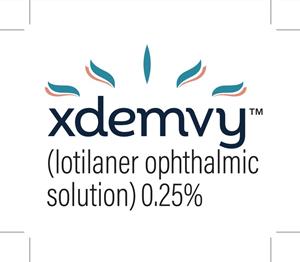Tarsus Pharmaceuticals, Inc. (NASDAQ: TARS), whose mission is to focus on unmet needs and apply proven science and new technology to revolutionize treatment for patients, starting with eye care, today announced that the U.S. Food and Drug Administration (FDA) approved XDEMVY™ (lotilaner ophthalmic solution) 0.25% for the treatment of Demodex blepharitis.
XDEMVY is the first and only approved therapeutic for Demodex blepharitis, a highly prevalent eyelid disease that impacts approximately 25 million eye care patients in the U.S.
XDEMVY targets the root cause of Demodex blepharitis and has demonstrated efficacy across multiple clinical measures of disease
XDEMVY expected to be available by prescription by the end of August 2023
Tarsus will host a webcast on July 25, 2023 at 5:30am PT / 8:30am ET
IRVINE, Calif., July 25, 2023 (GLOBE NEWSWIRE) -- Tarsus Pharmaceuticals, Inc. (NASDAQ: TARS), whose mission is to focus on unmet needs and apply proven science and new technology to revolutionize treatment for patients, starting with eye care, today announced that the U.S. Food and Drug Administration (FDA) approved XDEMVY™ (lotilaner ophthalmic solution) 0.25% for the treatment of Demodex blepharitis. XDEMVY, formerly known as TP-03, is the first and only FDA approved treatment to directly target Demodex mites, the root cause of Demodex blepharitis.
“We are thrilled to announce the FDA approval of XDEMVY for the treatment of Demodex blepharitis and look forward to making this product broadly available to the millions of patients who have not had any FDA approved therapeutics for this disease,” said Bobak Azamian, MD, PhD, Chief Executive Officer and Chairman of Tarsus. “This tremendous milestone was achieved through a successful collaboration of our talented Tarsus team, countless eye care providers and the hundreds of patients who participated in our trials. We are grateful and honored for the opportunity to introduce the first and only approved therapeutic for this disease to the eye care community.”
The FDA approval is based on results from two randomized, multicenter, double-masked, vehicle-controlled studies (Saturn-1 and Saturn-2), designed to evaluate the safety and efficacy of XDEMVY in 833 patients, 415 of which received XDEMVY. Patients with Demodex blepharitis were randomized to either XDEMVY or vehicle at a 1:1 ratio and dosed twice daily in each eye over the course of 6 weeks.
Efficacy was demonstrated by a significant improvement in eyelids (reduction of collarettes, the pathognomonic sign of the disease, to no more than 2 collarettes per upper lid) in each study by Day 43, with some patients seeing improvement as early as 2 weeks. Additionally, the endpoints of mite eradication (mite density of 0 mites per lash) and erythema cure (Grade 0) showed statistically significant improvement at Day 43 across both studies. In clinical trials, XDEMVY was generally safe and well tolerated. The most common ocular adverse reactions observed in the studies were instillation site stinging and burning which was reported in 10% of patients. Other ocular adverse reactions reported in less than 2% of patients were chalazion/hordeolum (stye) and punctate keratitis.
“After years of seeing Demodex blepharitis in my practice without an effective way to target the root cause of the disease, I’m so pleased to have a new treatment to offer my patients,” said Christopher Starr, MD, Associate Professor of Ophthalmology, Director of Refractive Surgery, Ophthalmic Education and the Cornea Fellowship Program at Weill Cornell Medicine, New York Presbyterian Hospital. “Demodex blepharitis, easily diagnosed by the presence of eyelash collarettes, can result in ocular damage in multiple ways, including irritation, eyelash distention or loss and inflammation, which can be uncomfortable for patients. This new medicine is a positive step forward for the treatment of this disease in many patients who have been struggling for years.”
“More than half of the patients in my practice present with Demodex blepharitis, and to date, we’ve not had any FDA approved therapies to treat the disease,” said Selina McGee, OD, FAAO, BeSpoke Vision. “Many patients have experienced redness, crusting and overall ocular discomfort for years and I am excited to finally be able to offer an FDA-approved treatment for my patients.”
Demodex blepharitis impacts approximately 25 million eye care patients in the U.S. – or 1 out of every 12 adults. It is a common yet often misdiagnosed or underdiagnosed eyelid disease that is caused by an infestation of Demodex mites, the most common ectoparasite found on human skin. Demodex blepharitis is characterized by redness, inflammation, missing or misdirected eyelashes, horizontal itching along the eyelid base and the presence of collarettes. Collarettes are cylindrical, waxy debris of mite waste products and eggs found at the base of the eyelashes.
For more information about XDEMVY and Full Prescribing Information, please visit www.xdemvy.com.
Webcast Information
Management will host a live webcast on July 25 and the webcast can be accessed on the events section of the Company’s Investor Relations website. After the live webcast, the event will remain archived on the Tarsus website for at least 90 days.
About Demodex Blepharitis
Blepharitis is a common lid margin disease that is characterized by eyelid margin inflammation, redness and ocular irritation. Demodex blepharitis is caused by an infestation of Demodex mites, the most common ectoparasite found on humans and accounts for over two-thirds of all blepharitis cases. Demodex blepharitis may affect as many as 25 million Americans based on an extrapolation from the Titan study indicating 58% of patients presenting to U.S. eye care clinics have collarettes, a pathognomonic sign of Demodex infestation, and that at least 45 million people annually visit an eye care clinic. Demodex blepharitis can have a significant clinical burden and negative impact on patients’ daily lives. The Titan study also showed that current management tools, such as tea tree oil and lid wipes, are ineffective at targeting the root cause of Demodex blepharitis.
About XDEMVY™
XDEMVY (lotilaner ophthalmic solution) 0.25%, formerly known as TP-03, is a novel prescription eye drop designed to treat Demodex blepharitis by targeting and eradicating the root cause of the disease – Demodex mite infestation. The active ingredient in XDEMVY is lotilaner, which is a well-characterized agent that eradicates Demodex mites by selectively inhibiting the mite’s GABA-Cl channels. It is a highly lipophilic molecule, which may promote its uptake in the oily sebum of the eye lash follicles where the mites reside. XDEMVY was evaluated in two pivotal trials collectively involving more than 800 patients. Both trials met the primary endpoint and all secondary endpoints, with statistical significance and no serious treatment-related adverse events. Most patients found the XDEMVY eye drop to be neutral to very comfortable. The most common ocular adverse reactions observed in the studies were instillation site stinging and burning which was reported in 10% of patients. Other ocular adverse reactions reported by less than 2% of patients were chalazion/hordeolum (stye) and punctate keratitis.
About Tarsus Pharmaceuticals, Inc.
Tarsus Pharmaceuticals, Inc. applies proven science and new technology to revolutionize treatment for patients, starting with eye care. Tarsus is advancing its pipeline to address several diseases with high unmet need across a range of therapeutic categories, including eye care, dermatology, and infectious disease prevention. XDEMVY (lotilaner ophthalmic solution) 0.25% is FDA approved in the United States for the treatment of Demodex blepharitis. Tarsus is also developing TP-03 for the treatment of Meibomian Gland Disease, which is currently being studied in a Phase 2a clinical trial. In addition, Tarsus is developing TP-04 for the potential treatment of Rosacea and TP-05, an oral tablet for the prevention of Lyme disease. TP-04 and TP-05 are both currently being studied in Phase 2a clinical trials to evaluate safety, tolerability, and proof-of activity.
XDEMVY Indication and Important Safety Information
INDICATIONS AND USAGE
XDEMVY is indicated for the treatment of Demodex blepharitis.
Most common side effects: The most common side effect in clinical trials was stinging and burning in 10% of patients. Other side effects in less than 2% of patients were chalazion/hordeolum and punctate keratitis.
Handling the Container: Avoid allowing the tip of the dispensing container to contact the eye, surrounding structures, fingers, or any other surface in order to minimize contamination of the solution. Serious damage to the eye and subsequent loss of vision may result from using contaminated solutions.
When to Seek Physician Advice: Immediately seek a physician’s advice concerning the continued use of XDEMVY if you develop an intercurrent ocular condition (e.g., trauma or infection), have ocular surgery, or develop any ocular reactions, particularly conjunctivitis and eyelid reactions.
Use with Contact Lenses: XDEMVY contains potassium sorbate, which may discolor soft contact lenses. Contact lenses should be removed prior to instillation of XDEMVY and may be reinserted 15 minutes following its administration.
For additional information, please see full prescribing information available at: www.xdemvy.com.
Forward-Looking Statements
Statements in this press release about future expectations, plans and prospects, as well as any other statements regarding matters that are not historical facts, may constitute “forward-looking statements.” These statements include statements regarding the timing and availability of XDEMVY for prescription; potential market size for XDEMVY; Tarsus’ commercialization plans for and the anticipated benefits of XDEMVY; and the quotations of Tarsus’ management and consultants/eye care providers. The words, without limitation, “believe,” “contemplate,” “continue,” “could,” “estimate,” “expect,” “intend,” “may,” “might,” “plan,” “potential,” “predict,” “project,” “should,” “target,” “will,” or “would,” or the negative of these terms or other similar expressions are intended to identify forward-looking statements, although not all forward-looking statements contain these or similar identifying words. Actual results may differ materially from those indicated by such forward-looking statements as a result of various important factors. Further, there are other risks and uncertainties that could cause actual results to differ from those set forth in the forward-looking statement and they are detailed from time to time in the reports Tarsus files with the Securities and Exchange Commission, including Tarsus’ Form 10-K for the year ended December 31, 2022 filed on March 17, 2023 and the most recent Form 10-Q quarterly filing filed with the SEC on May 9, 2023, each of which Tarsus incorporates by reference into this press release, copies of which are posted on its website and are available from Tarsus without charge. However, new risk factors and uncertainties may emerge from time to time, and it is not possible to predict all risk factors and uncertainties. Accordingly, readers are cautioned not to place undue reliance on these forward-looking statements. Any forward-looking statements contained in this press release are based on the current expectations of Tarsus’ management team and speak only as of the date hereof, and Tarsus specifically disclaims any obligation to update any forward-looking statement, whether as a result of new information, future events or otherwise.
Contacts:
Media Contact:
Adrienne Kemp
Sr. Director, Corporate Communications
(949) 922-0801
akemp@tarsusrx.com
Investor Contact:
David Nakasone
Head of Investor Relations
(949) 620-3223
DNakasone@tarsusrx.com
Photos accompanying this announcement are available at
https://www.globenewswire.com/NewsRoom/AttachmentNg/e29d3564-45b2-49b3-b5f7-451c12630fe6
https://www.globenewswire.com/NewsRoom/AttachmentNg/6b62917c-8c98-4a26-a2e7-ae647cff556c








